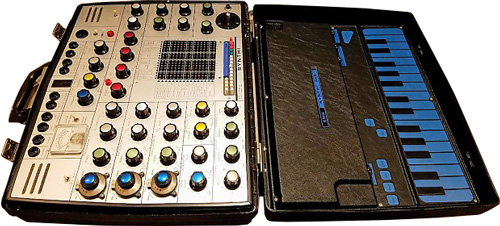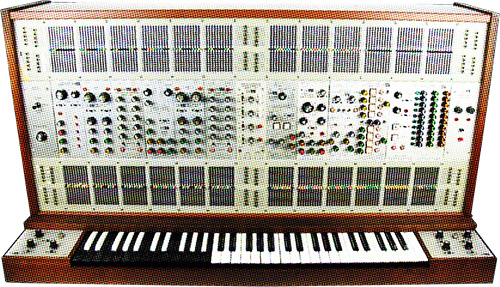Sources
It should be remembered that the first musical instruments using non-acoustic sound generation processes appeared at the beginning of the 20th century.
The first of these instruments is the Dynamophone (or Telharmonium) conceived by Thaddeus Cahill from 1897 and presented in public for the first time in 1906.
It was not until the inter-war period that the first electronic instruments appeared. The main ones are the Theremin presented in 1924, the Ondes Martenot and the Trautonium presented in 1930. Most of these instruments used a keyboard and could only play one note at a time.
The new sound generation processes attracted the attention of the Futurist movement which sought to imitate industrial sounds.
Marinetti or Pratella affirmed the musical intentions of this movement which were later expressed in “The art of noise” by Luigi Russolo. He proposed to use environmental sound sources in musical composition:
“Musical sounds are too limited to qualitative varieties of timbre. The most complex orchestras are limited to four or five categories of instruments of different timbres: bowed instruments, plucked instruments, the brass family, the woodwind family and percussion instruments… We must leave this restricted circle of pure musical sounds and conquer the infinite variety of sounds” (1913).
These proposals were materialized by the construction of noisy instruments: the Intonarumori, in collaboration with the percussionist Ugo Piatti.
These prophetic inventions attracted the attention of Edgar Varèse, who remains the composer of his time who contributed most to the acceptance of diverse sound sources in musical composition through his compositions.
His work was followed by John Cage, then a young composer who already in 1937 declared:
“Whereas in the past the points of divergence were between dissonance and consonance, in the near future it will be between noise and so-called musical sounds. Wherever we are, all we hear is mostly noise… We want to capture and control these sounds, we do not want to use them as studio treatments but as instruments… The specific characteristics of electric instruments will be to give total control over the harmonic structure of the sounds (as opposed to noise) and to make these sounds usable at any frequency, amplitude and duration.”
This would be made possible by the technique of Sound Synthesis.
The first modular synth was developed by Harald Bode in the late 1950s:
https://www.perfectcircuit.com/signal/harald-bode
In the 60s Don Buchla on the West coast and Robert Moog on the East coast originated Modular Synthesis when making possible Control Voltage…
Buchla tended to not refer to his instruments as synthesizers, since the name connotes imitating existing sounds and/or instruments. Rather, his intent is to make instruments for creating new sounds, avoiding the use of keys so that the musician isn’t playing traditionally… While Moog was interested in making playable devices for performers in the mainstream.
Modular Synthesis gives the ability to connect or “patch” modules together in whatever way the composer wants in order to create unique, never-before-heard sounds, constructing unique signal paths capable of synthesizing sounds. Whereas in self-contained, non-modular gear, there are hardwired connections under the hood and the functionality is relatively fixed regarding the number of oscillators, LFOs, envelopes, etc., that are built into the device. With modular, there is the ability to expand the system in infinite ways, simply by adding more modules. Devices control are controlled by other devices by means of CV (control voltage), the lifeblood of modular. Patch cables are used to send voltage throughout multiple units interacting with one another – with signal generators used to create sound that is then passed through a labyrinth of oscillators, envelope generators, filters, voltage controlled amplifiers and sequencers. THOUGH one has to bear in mind that Modular Synthesis isn’t about Modules… It’s not about the character of the Module itself BUT bringing together a collection of functions ! Knowing how to use/interact them so as to become our own unique instrument.
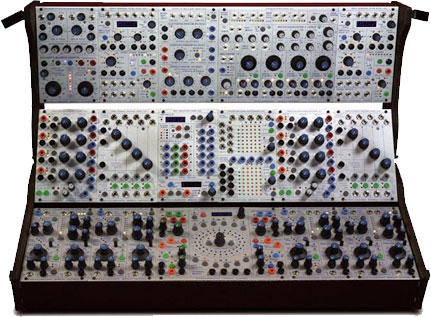
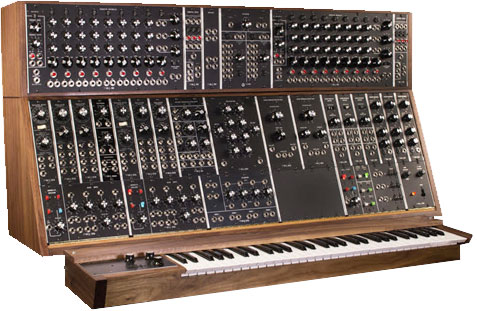
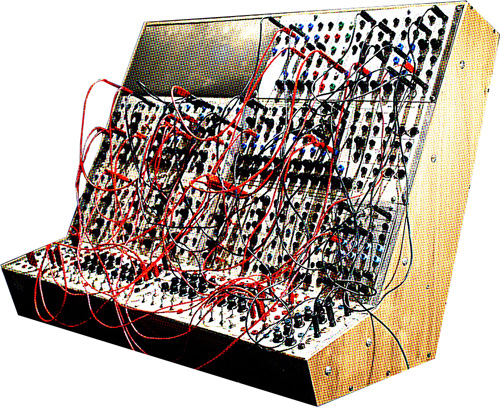
Here are the main components of a system:
- Case and Power Supply – Euroracks are typically in rows of 3U or 3 rack spaces each and measured horizontally in terms of HP (horizontal pitch). Typical widths are 84 and 104 HP. Obviously, more room in a rack will lead to more investment, because no one likes an empty space in their rack. Some racks come with built-in power and some will need a power supply purchased separately. The investment in a rack is typically one of the largest cash outlays and should not be taken lightly. Try to project your future needs and portability requirements before making a choice.
- Oscillators or Full Synth Voices – The number of voices is how many notes you can play at once. This is the polyphony. Each voice is made from a number of oscillators. An electronic oscillator is an electronic circuit that produces a periodic, oscillating electronic signal, often a sine wave or a square wave.[Oscillators convert direct current (DC) from a power supply to an alternating current (AC) signal. An oscillator can be designed so that the oscillation frequency can be varied over some range by an input voltage or current: Voltage Controlled Oscillator.
- VCFs – Voltage Controlled Filters – A voltage-controlled filter (VCF) is an electronic filter whose operating characteristics (primarily cutoff frequency) can be set by an input control voltage.[1] Voltage controlled filters are widely used in analogue music synthesizers. A music synthesizer VCF allows its cutoff frequency, and sometimes its Q factor (resonance at the cutoff frequency), to be continuously varied.
- Envelope Generators – Envelope Generators are circuits that, when triggered, produce a contoured signal over time. Often used to control volume, EG’s can give a natural or unnatural character to a played note by giving the synthesist control over how fast the volume rises from silence to full volume, also known as the Attack Phase as well as how long it takes for the sound to fade out after a key is released, also known as the Release Phase. These parameters enable you to determine whether your notes will sound like a click with a fast attack and a fast release, a percussive sound with a fast attack and a slower release, or a sound that fades in with a long attack. You will often find EG’s with more phases such as the classic ‘Attack, Decay, Sustain, Release’ paradigm. ADSR.
- LFOs – Low-frequency oscillation (LFO) is an electronic frequency which is usually below 20 Hz and creates a rhythmic pulse or sweep. Audio effects such as vibrato, tremolo and phasing are examples.
- VCAs – Voltage Controlled Amplifiers – An amplification circuit whose gain is controlled by an external voltage. VCAs are commonly used in synthesizers to create the volume envelope of sounds.
- Utility and other modules which may include:
- Multiples for duplicating a signal
- Mixers
- Waveform Processor
- Slew Limiter
- Effect Processor (Delay/Reverb, etc.)
- Clock divider
- Attenuverters
- Random Voltage Generators
- Interface modules for getting MIDI and/or Audio in/out
- Loads of cables…
One can plan his system on Modulargrid platform.
A glossary of terms and many great resources thru their pages:
https://learningmodular.com/glossary/
French-speaking #1 resource:
https://www.synthe-modulaire.com
